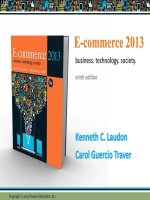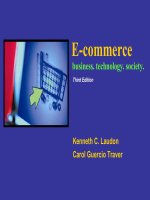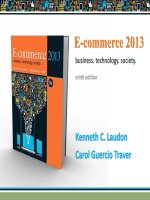Lecture E-commerce (7/e): Chapter 9 - Kenneth C. Laudon, Carol Guercio Traver
Bạn đang xem bản rút gọn của tài liệu. Xem và tải ngay bản đầy đủ của tài liệu tại đây (772.49 KB, 45 trang )
Ecommerce: Business. Technology.
Society
Ecommerce
business. technology. society.
seventh edition
Kenneth C.
Laudon
Carol Guercio
Traver
Copyright © 2011
Pearson Education, Inc.
Copyright © 2011 Pearson Education, Inc.
Chapter 9: Online Retail and Services
Chapter 9
Online Retail and Services
Copyright © 2011
Pearson Education, Inc.
Copyright © 2010 Pearson Education, Inc.
Copyright © 2011 Pearson Education, Inc.
Slide 92
Blue Nile Sparkles For Your Cleopatra
Class Discussion
Why is selling (or buying) diamonds over the
Internet difficult?
How has Blue Nile built its supply chain to keep
costs low?
How has Blue Nile reduced consumer anxiety
over online diamond purchases?
What are some vulnerabilities facing Blue Nile?
Would you buy a $5,000 engagement ring at
Copyright © 2011
Blue Nile?
Pearson Education, Inc.
Slide 93
Major Trends in Online Retail,
20102011
Growth in social shopping
Online retail remained profitable during
recession
Online retail still fastest growing retail channel
Buying online a normal, mainstream experience
Selection of goods increases, includes luxury
goods
Copyright © 2011
Informational shopping for big-ticket items
Pearson Education, Inc.
Slide 94
The Retail Sector
Most important theme in online retailing is effort
to integrate online and offline operations
U.S. retail market accounts for $10 trillion (70%)
of total GDP
Personal consumption:
Services:
61 %
Nondurable
Durable
goods: 29 %
goods: 10 %
“Goods” vs. “services” ambiguity
Copyright © 2011
Pearson Education, Inc.
Slide 95
The Retail Industry
8
segments (clothing, durable goods, etc.)
For
each, uses of Internet may differ
Information
General
vs. direct purchasing
merchandisers vs. specialty
retailers
order/telephone order (MOTO) sector
most similar to online retail sector
Sophisticated
order entry, delivery, inventory
Copyright © 2011
control systems
Pearson Education, Inc.
Slide 96
Composition of the U.S. Retail Industry
Copyright © 2011
Pearson Education, Inc.
Figure 9.1, p. 579
SOURCE: Based on data from U.S. Census Bureau,
2010
Slide 97
Ecommerce Retail: The Vision
1.
Reduced search and transaction costs; customers
able to find lowest prices
2.
Lowered market entry costs, lower operating costs,
higher efficiency
3.
Traditional physical store merchants forced out of
business
4.
Some industries would be disintermediated
Few of these assumptions were correct—structure of
retail marketplace has not been revolutionized
Internet has created new venues for multichannel firms
and supported a few pure-play merchants
Copyright © 2011
Pearson Education, Inc.
Slide 98
The Online Retail Sector Today
Smallest
segment of retail industry (6%)
Growing at faster rate than offline
segments
Revenues expected to resume 10-15%
growth between 2010 – 2014
72% of Internet users bought online in
2010
Primary beneficiaries:
Established offline retailers with online
Copyright © 2011
presence (e.g. Staples)
Pearson Education, Inc.
Slide 99
Online Retail and B2C Ecommerce is Alive and
Well
SOURCES:
Copyright © 2011
Figure 9.2, p.582
Pearson Education, Inc.
Based on data from eMarketer, Inc., 2010a; authors’
estimates.
Slide 910
MultiChannel Integration
Integrating
Web operations with traditional
physical store operations
Provide
integrated shopping experience
Leverage value of physical store
Types
of integration
Online
order, in-store pickup
In-store kiosk or clerk Web order, home delivery
Web promotions to drive customers to stores
Gift cards usable in any channel
Copyright © 2011
Pearson Education, Inc.
Slide 911
Analyzing the Viability of
Online Firms
Economic
viability:
Ability
of firms to survive as profitable
business firms during specified period (i.e. 1-3
years)
Two
business analysis approaches:
Strategic
Focuses
analysis
on both industry as a whole and firm itself
Financial
Copyright © 2011 analysis
How firm is performing
Pearson Education, Inc.
Slide 912
Strategic Analysis Factors
Key
industry strategic factors
Barriers to entry
Power of suppliers
Power of customers
Existence of substitute products
Industry value chain
Nature of intra-industry competition
Firm-specific
factors
Firm value chain
Core competencies
Synergies
Technology
Social and legal challenges
Copyright © 2011
Pearson Education, Inc.
Slide 913
Financial Analysis Factors
Statements
of Operations
Revenues
Cost
of sales
Gross margin
Operating expenses
Operating margin
Net margin
Pro forma earnings
Balance
sheet
Assets,
current assets
Liabilities, current liabilities and long-term debt
Copyright © 2011
Working capital
Pearson Education, Inc.
Slide 914
Etailing Business Models
1.
Virtual merchant
1.
Bricks-and-clicks
1.
Wal-Mart, J.C. Penney, Sears
Catalog merchant
1.
Amazon
Lands’ End, L.L. Bean, Victoria’s Secret
Manufacturer-direct
Dell
Copyright © 2011
Pearson Education, Inc.
Slide 915
Ecommerce in Action: Amazon.com
Vision:
Earth’s biggest selection, most customer-centric
Business
Amazon Retail, Third Party Merchants, and Amazon Web Services
(merchant and developer services)
Financial
analysis:
Greatly improved, profitable; still heavy long-term debt
Strategic
model:
analysis/business strategy:
Maximize sales volume, cut prices
Strategic
analysis/competition:
Online and offline general merchandisers
Copyright © 2011
Pearson Education, Inc.
Slide 916
Ecommerce in Action: Amazon.com
Strategic analysis/technology:
Largest,
most sophisticated collection of online
retailing technologies available
Strategic analysis/social, legal:
Antitrust,
sales tax, patent lawsuits
Toys“R”Us suit settlement, State of New York lawsuits
Future prospects:
In
2009, net sales grew 28%, and significant gains
thus far in 2010
Ranks among top five in customer service, speed,
accuracy
Copyright © 2011
However, net margins still much narrower than WalPearson Education, Inc.
Slide 917
Common Themes in Online Retailing
Online retail fastest growing channel on revenue
basis
Profits for startup ventures have been difficult to
achieve
Disintermediation has not occurred
Most significant online growth: Offline general
merchandiser giants extending brand to online
channel
Second area of rapid growth:
Specialty
merchants with high-end goods, e.g. Blue
Copyright © 2011
Nile
Pearson Education, Inc.
Slide 918
Insight on Technology
Using the Web to Shop ’Till You Drop
Class Discussion
What do shopping bots and comparison sites
offer consumers?
Why are shopping bots more successful with
hard goods than soft goods?
What is the strategy of Shopping.com?
How can shopping bots compare luxury goods?
How does adding content to comparison sites
Copyright © 2011
help consumers?
Pearson Education, Inc.
Slide 919
The Service Sector: Offline and Online
Service
sector:
Largest
and most rapidly expanding part of
economies of advanced industrial nations
Concerned
with performing tasks in and
around households, business firms, and
institutions
Includes doctors, lawyers, accountants, business
consultants, etc.
76%
of U.S. labor force - 108 million
Copyright © 2011
58% of GDP - $7.7 trillion
Pearson Education, Inc.
Slide 920
Service Industries
Major
service industry groups:
Finance
Insurance
Real
estate
Travel
Professional services – legal, accounting
Business services – consulting,
advertising, marketing, etc.
Health services
Educational services
Copyright © 2011
Pearson Education, Inc.
Slide 921
Service Industries
Two
categories
Transaction
brokers
Hands-on service providers
Features:
Knowledge-
and information-intense
Makes
them uniquely suited to e-commerce
applications
Amount
of personalization and customization
required differs depending on type of service
e.g. medical services vs. financial services
Copyright © 2011
Pearson Education, Inc.
Slide 922
Online Financial Services
Example
of e-commerce success story,
but success is somewhat different from
what had been predicted
Brokerage
4
industry transformed
of 5 households use online banking
Effects
less powerful in insurance, real
estate
Multi-channel
established financial
Copyright © 2011
services firms continue to show strong
Pearson Education, Inc.
Slide 923
Financial Service Industry Trends
Two
important global trends
Industry
consolidation
Financial
Reform Act of 1998 amended
Glass-Steagall Act and allows banks,
brokerages, and insurance firms to merge
Movement
toward integrated financial
services
Financial
supermarket model
Copyright © 2011
Pearson Education, Inc.
Slide 924
Industry Consolidation and Integrated
Financial Services
Copyright © 2011
Figure 9.3, Page 606
Pearson Education, Inc.
Slide 925









